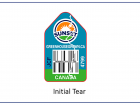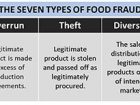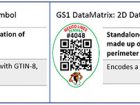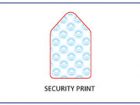
Features
Business
Management
5 ways to fight food fraud
These labelling tactics could help curb problems of food fraud worldwide.
June 3, 2019 By Joe Sleiman

Food fraud is a growing problem, costing the global food trade an estimated $30-$40 billion USD in annual losses, and it can put public health at risk. While the term is typically defined as ‘intentional deception using food for economic gain’ there are seven different types of food fraud, as laid out in the chart below.
Labelling can be an important ally in an effort to eliminate food fraud in our complex global chain. Millions of labels are counterfeited every year, all across the globe. If you are a grower, processor, packer or shipper, here are five key steps you can take to reduce the risk of food fraud holding your business hostage one day:
Step #1: Do your due diligence
You want to start by critically assessing your supply chains in order to best mitigate your risks. An in-depth understanding of your end-to-end supply chain can be the single most impactful action you can take to develop a trusted and reliable network of suppliers and customers.
Questions you can ask include:
- How many years has this vendor been in business? It is useful to look at past performance as an indicator of future success. If the vendor is a new establishment (in business one to three years) the next step is to look into the credibility of the top management and leadership team. Keep in mind that eighty per cent of businesses fail in the first five years. Pick a partner that has staying power, because their reputation can easily impact yours.
- How many reputable customers does this vendor serve? A red flag would be a situation where a large percentage (50 to over 75 per cent) of total customers are small and/or speculative businesses. It may be valuable to investigate existing customers and contact them to learn about their business and degree of satisfaction in working with the vendor in question. Word of mouth referrals go far in business but it’s also advisable to contact references and capture information from the primary source.
- Do any external parties perform audits on this business? Is the business in compliance with international, national or retail standards? Compliance with global food safety standards remains a foundational tool in performing due diligence, and most of the largest food retailers mandate supplier certification using established schemes such as the Global Food Safety Initiative (GFSI), International Featured Standard (IFS), or Safe Quality Foods (SQF). Many certifications exist, so be sure to investigate what is required for your business and if all stakeholders are in compliance.
- What types of internal controls are in place to prevent fraud? Has the vendor established a corporate culture that actively promotes coordination between operations, procurement, sales and marketing departments to predict and prevent food fraud? Does the vendor value training for technical, buying and operations departments? Is there a defined whistle-blowing protocol by staff? The first step in solving any problem is recognizing that a problem exists. Thus, strong leadership will ultimately take the initiative to lower the risk of fraud acceptance.
- What fraud-prevention processes, people or technology are in place? There has been a growing body of knowledge
in the field of new analytical and computational tools. This has shifted the industry from detection and mitigation, into prediction and prevention. Does the vendor have an established food safety committee? Has this vendor embraced data-sharing to promote traceability, transparency and trust amongst its supply chain? Furthermore, has this vendor established a well-defined plan for risk management in the event of an emergency?
Step #2: Explore alternative labelling technologies
A number of labelling technologies are available to help stop food fraud. Here are some of the best:
Pre-printed labels versus real-time print-and-apply: Preprinted fruit labels include currently mandated Global Trade Item Number (GTIN) standard GS1 barcodes that have up to 14 digits for identifying a specific grower/marketer, as well as a Price Look Up (PLU) number that has up to 5 digits to identify specific fruit or vegetables at a grocery store. An inherent limitation is the inability to print trace/lot code data due to the nature of pre-printed labels.
Technological advances provide the ability to print variable data in real-time, such as a DataMatrix (‘2D barcode’) which can include trace/lot code information in up to 96 digits in the same space. These additional digits can be used towards encoding relevant supply chain information and be used as a snapshot of a fruit or vegetable’s journey from farm-to-fork.
Security Print – is this something that can be tailored? This technology provides verification and proof of authenticity using invisible ink watermarks under the label with reverse print technology.
Destructible Security Labels – with paper barrier: These break apart when removed from fruit to prevent reapplication on another fruit.
Step #3: Apply trace code and variable data to achieve item-level traceability
Once fruit leaves the pack house, it is handled many times before it’s consumed. Fruit that has been shipped in a tray will be dumped onto a bed of “bulk” fruits making it difficult to differentiate one fruit from another unless they are properly labelled. According to the United Nations’ Food and Agriculture Organization (FAO) more than $680 billion of food is wasted each year in industrial countries and more than $310 billion in developing nations. It’s said that more than 40 per cent of the food waste occurs at consumer and retailer levels due to product spoilage or recalls from contamination. Trace code is the system used to track produce back to its point of origin (backward traceability) and forward as it is processed and becomes an end product that is eventually consumed (forward traceability). Trace code can help prevent food waste as food systems can become more nimble in identifying, containing and handling at-risk produce versus throwing away entire product lines or categories. Increased traceability not only has the power to minimize food waste, but it can also maximize food safety to fight food fraud.
Step #4: Improve application rates to prevent unlabelled fruits
Within labelling, the application rate is defined as the number of product labelled as a percentage of the total product. Retailers have instituted strict quality controls on suppliers to achieve high application rates. Walmart US demands a 95 per cent label application rate, or else shipments will be returned to suppliers as rejected product. Unlabelled fruit creates an opportunity for fraudsters, allowing more leeway for mixing fruits that might be grown in substandard growing conditions.
Step #5: Understand the impact of transformative technologies
Blockchain, the technology behind Bitcoin and other cryptocurrencies, is essentially a decentralized record-keeping system that is tamperproof. Using blockchain, supply chains can be transformed to become more transparent, traceable and trusting with the use of shared ledgers that can be accessed by all members of the supply chain. Walmart US has implemented blockchain technologies to improve the traceability of mangos from six days to two seconds. A successful pilot project with IBM’s Food Trust has led Walmart to mandate that all suppliers in the leafy greens category must have their products on the blockchain within one year.
The hyper connected IoT (Internet of Things) is a technological movement in agriculture where greenhouses are outfitted with wireless connectivity via sensors, allowing for communication amongst systems without human intervention. For example, high-tech greenhouses capture data via sensors on light, humidity, temperature, soil moisture, etc., and optimize growing conditions accordingly. Sensors such as RFID tags are becoming increasingly inexpensive, and they can be used to seamlessly track products across the value chain to ensure authenticity. These types of smart sensors draw a meaningful connection between external stakeholders (e.g. CFIA, retailers, consumers) who can identify contaminated product and trigger internal stakeholders (growers, quality assurance teams) to respond and to mitigate further risk in the greenhouse – all in real-time. Automation tools deliver the infrastructure to streamline processes, reduce human error and maximize efficiencies.
Food fraud is an ongoing threat to food safety, however it’s clear that advanced labelling technologies and innovations can be used to combat fraudsters and safeguard our food systems. It’s an unavoidable cost, but reliable machinery could be key to success. High-speed labelling systems could even lead to higher throughput and efficiency. What is your operation doing to ensure the quality of your produce?
Joe Sleiman is president of Ag-Tronic Control Systems Inc. and Accu-Label Inc. Learn more at www.accu-label.com. This article was edited and reprinted with permission from Global Food Safety Resource (GFSR).
Print this page




